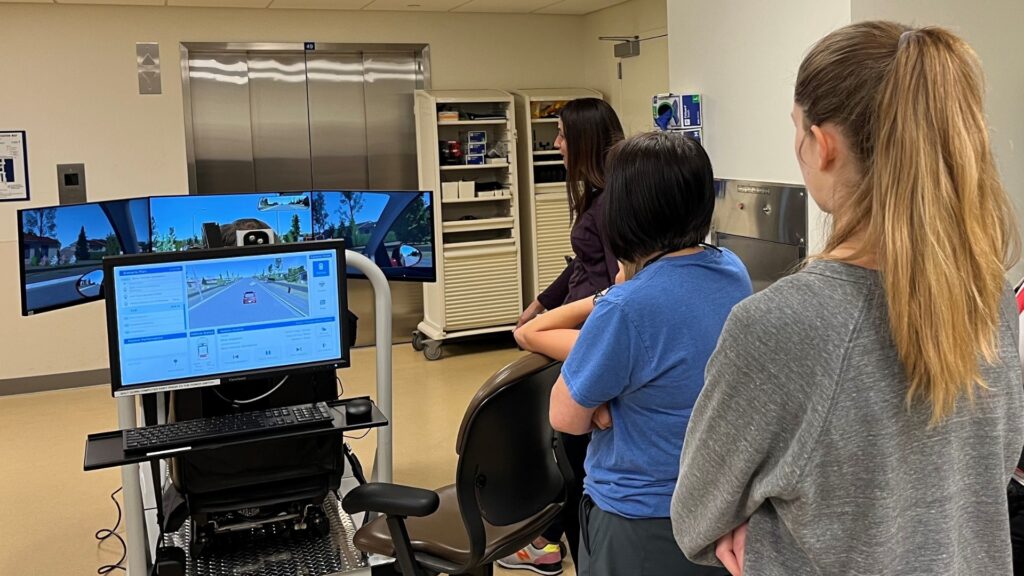OVERVIEW
We recently partnered with a large hospital that provides world-class inpatient and outpatient rehabilitation programs. Driving assessments are a core feature of their return to driving program, and they already had one adaptive vehicle for on-the-road assessments and to train clients on adaptive hand controls.
To complement this capability, the hospital purchased a STISIM Drive® M4000 simulator to use for assessment, intervention, and evaluation of patients prior to using the adaptive vehicle. They will be using the simulator for both inpatient and outpatient clients for skills development, adaptive hand control training, and visual and cognitive testing.
To better leverage the power of the STISIM Drive® G4 Clinical Application for their clinical staff and patients, our partner also purchased the Navigator™ Training Program.
As is typical in the day-long Navigator™ curriculum, the primary outpatient OTs attended the full training, while the entire inpatient and outpatient team of therapists attended an overall demo of the driving simulator during lunch. Evaluation of two actual patients of the clinic followed the lunch session.
PATIENT SESSIONS
The first patient had a stroke approximately five years prior and his left side was affected. His goal of returning to driving has been a priority since his stroke. He has significant visual field cuts in his left eye and is unable to see objects on the left until they are in his central point of view. His OT has previously discussed with him that returning to driving may not be a possibility due to the visual field cuts. The client stated that utilizing the simulator will still be rewarding as a motivator to return to driving. To accommodate for the client’s height, we slightly separated the front and back portions of the M4000.
The therapists then performed a baseline collection of data for his evaluation utilizing Brake Reaction Time, Steering Reaction Time, Steering Range of Motion, and Divided Attention scenarios. The client performed well during the reaction time non driven, however during the Divided Attention drive the client was unable to visually see the symbols within his peripheral vision on the left. He attempted to utilize an adaptive technique of turning his head to the left to scan on his left side, with the use of his right eye, however was unable to maintain lane position.
The client reported a positive experience on the simulator and stated he now understands why driving may not be possible for him due to his vision loss. He would like to continue utilizing the simulator to practice his visual scanning skills and found it to be helpful with skills development.
The second client sustained a brain injury due to an Aneurysm followed by a stroke. While he did not have any physical impairments (limitations in one side of his body), his deficits presented more cognitively with decreased processing speed, reaction time, and following instructions. The therapists performed the same non driven and driven assessments and added the Basic Vehicle Operations and Freeway scenarios.
The client had significant delays during BRT and SRT as he had challenges understanding the task and decreased motor planning/coordination with moving foot from accelerator to brake. The client required moderate verbal cues to understand the task and therefore therapists performed BRT, SRT twice to gain a better understanding of his response/reaction time. During the basic vehicle drive, the client was delayed in following verbal instructions for turning requiring multiple attempts. The therapists utilized the ability to go back to a certain point in the drive to practice following instructions. This key feature they felt was a benefit for this client.
CONCLUSIONS
By the end of the patient sessions, the therapists had a solid understanding of the application of our new G4 Clinical Application in developing best practices and improving patient outcomes.
The therapists were enthusiastic about the ability to save plans, customize plans, and using the playback feature for patient education. The therapists reported that they enjoyed the usability of the interface, ability to create and save plans, the changing of weather and time of day, along with the therapist monitor being on a movable arm.
But most of all, the therapists were thrilled with the way Navigator training allowed them to be hands-on and effective from the first day of having their new simulator. STI is proud to bring the community such a powerful combination of capabilities with the M4000 console, G4 Clinical Application and Navigator™ products.
Contact us to discuss how our products and training can make a difference for your clinic or hospital.

